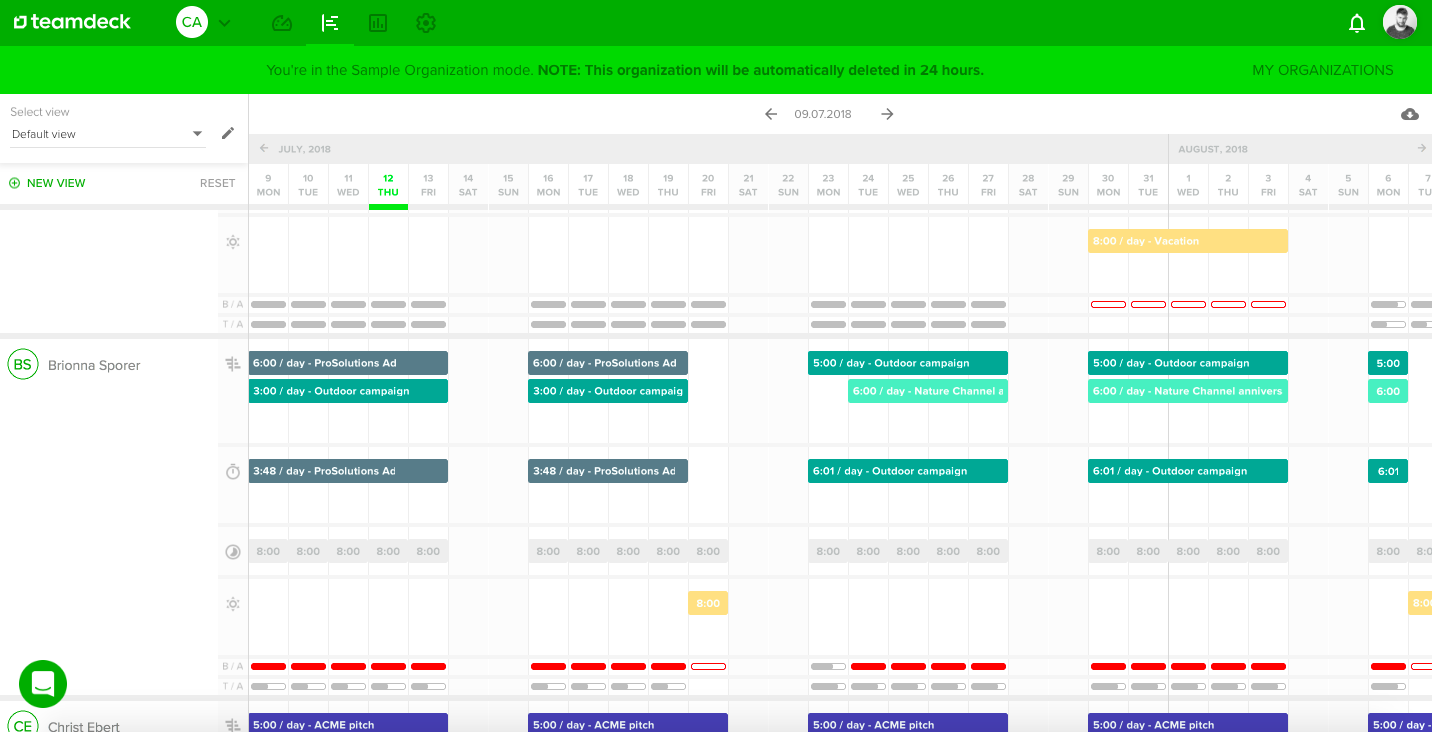资源日历--用一个工具管理整个团队
资源日历(或项目管理日历、或项目规划日历、资源规划软件)可让您更有效、更高效地规划、管理和分配资源--尤其是如果 Microsoft Excel 在您的项目中发挥了主导作用。
资源分配可帮助您为多个项目选择最佳可用资产,并在整个工作过程中对其进行管理,从而避免员工使用不足或过度使用。遗憾的是,并不是所有的项目经理都能充分利用资源分配。
感谢这篇文章,您将得到什么?
根据 PMI 的调查("Pulse of the Profession"),只有 26% 的公司始终使用资源管理来估算和分配资源,其中 36% 的公司经常这样做。 与此同时,只有不到 60% 的项目达到了最初的预算要求,只有 50% 的项目能够按时完成。
许多项目经理在介绍什么是项目管理时,都会使用项目管理协会(PMI)的定义。根据最后一个定义,项目管理就是不惜一切代价为人们提供有益的东西--正如他们所说的那样,"为人们提供价值"。
更确切地说,APM 认为,项目管理就是利用一些能力、才干、专长、工具、机器、仪器、软件、方法、技术和流程来 "为人们创造价值"。

"对人的价值 "这句话让我们联想到项目管理的成果可以是一切。一栋房子、一个应用程序、一个公园,甚至一些社会运动,包括十字军东征、LGPT 或宗教。任何对某些人群有用的东西都可以。
上述评论正是我们--业务嵌入人员--使用项目管理协会(APM)提出的定义的原因。所提出的对项目管理的理解包含一些标准,有助于将单纯的管理与项目管理区分开来。让我们来看看:
项目管理是对流程、方法、技能、知识和经验的应用,目的是在商定的参数范围内,根据项目验收标准实现特定的项目目标。项目管理的最终交付成果受限于有限的时间范围和预算。

当我们比较 APM 和 PMI 的定义时,我们会发现两者有一些相似之处。二者都是关于管理和使用知识、经验、方法等完成工作。 但是,只有项目管理的最后一个特征--我们想说--是商业性的。
时间、预算和 "项目验收标准 "是真正的项目管理(当然也包括资源管理或资源分配过程)。我们所知道的是,在商业关系世界中,任何项目都有其目标。任何项目都必须在特定的时间、特定的预算内完成,并且必须得到委托人--无论是客户还是公司主管--的认可。
这就是管理与项目管理的主要区别。管理是一个持续不断的过程。项目管理则是在有限的时间跨度和预算内提供最终结果。
这种区分的结果是,项目管理不仅是一个过程,而且是一个结构化的过程。它被称为项目管理生命周期,通常分为 5 个阶段。
就像我们在资源分配系统市场上的竞争对手甘尼克公司一样,资源分配和 资源规划 (资源管理)是项目管理生命周期过程的一个方面。他们负责规划、组织资源(员工)并衡量其生产率(没错,这就是上文提到的项目管理流程的第四阶段)。
现在,我们知道在项目管理生命周期的背景下,在哪里可以找到资源管理。现在是了解资源管理的时候了。为什么呢?因为资源分配是资源管理的一部分,而资源管理--大家已经知道--是项目管理流程的一部分。
得益于 APM 知识体系,我们知道资源的含义非常广泛。资金、工具、机械、技术,以及最重要的--人员及其技能。资源意味着完成任务和项目所需的一切。
那么,资源分配与资源管理(资源规划)之间有什么联系呢?让我们来看看 APM 给出的定义。在他们看来,资源管理是
(......) 获取、分配和管理项目所需的资源(......)。资源管理确保内部和外部资源在预算范围内按时得到有效利用。
正如我们所看到的,与项目管理的定义相同,时间和预算是这一过程中至关重要的方面。此外,我们还不应将 "验收标准 "排除在外。
然而,资源管理被理解为规划、选择、安排和分配资源以满足验收标准和完成项目的过程。
在资源管理和资源分配中,资源分配的要素是确定可用和充足的资源,并在适当的时间将其与适当的任务相匹配。而资源或项目经理的职能是确定具备相关技能和经验的员工(即所谓的资源)来完成工作(这是规划的一部分),并决定何时需要特定资源(通过资源分配或资源调度)。
这篇文章可能会让一些经验不足的人觉得做起来应该不难。因此,在本章的最后,我们将使用惠灵顿公司的年度报告。

在讨论项目管理中资源分配的含义之前,我们先来了解一下本文中最重要的术语之一--资源。感谢这段介绍,你会更好地感受到下文中提到的资源分配的一些定义之间的区别。
可以想象,资源可以是绝对不同的--从物质到非物质。在资源分配方面也不例外,但对 "资源 "含义的理解取决于所使用的行业。

在本章中,您将看到许多品牌,包括我们的商业竞争对手。 我们比较了 Brittanica Dictionary 提供的一些定义和含义,同时也比较了我们的知名竞争对手--Wrike、Resource Guru 或 TeamGantt 公司。其含义从较为笼统到较为精确,且与项目管理活动相关。
剑桥词典》指出,资源分配是指
在组织内部各部门之间分配资金、技能等的过程。
在另一本非常著名的《布列塔尼卡词典》(Brittanica Dictionary)中有更严格的解释,说明了我们这个词的经济背景。资源分配被理解为
在不同用途之间分配生产性资产。(布里塔尼卡词典)

但是,作为项目管理行业的一部分,我们将重点关注与该行业相关的含义。因此,Float(我们的竞争对手和著名的项目管理资源分配软件供应商)在其一篇博客文章中告诉我们,r资源分配是指定和处理资产以帮助团队完成任务、项目和战略目标的过程。
但在继续阅读和更准确地理解时,Float 强调了资源分配的两个方面。首先是匹配。资源配置意味着将员工或团队成员的能力和经验与合适的项目或任务相匹配。而(相关)匹配是其对资源分配理解的两个关键要素之一。
其次,要确保每个团队成员和每个参与项目的员工都能执行每项任务和管道中的任何工作。
从 Saviom 的角度来看,这是另一款旨在帮助项目经理进行资源管理的软件:
资源分配又称资源调度,是指在特定时期内为各种活动确认和分配资源。
这些活动--正如我们在其他地方看到的那样--可以与项目有关,也可以无关。行政、支持、运营等。在这里,Saviom 提醒大家注意认识到资源分配过程中的第一个重要因素。其次--与其他许多要素一样--分配。第三个要素是 "特定时期"。

在 projectmanager.com 网站上,我们被告知资源分配一词与资源管理和资源调度的含义相同(下一段将详细介绍)。而实际上,从他们的角度来看,资源分配只是一种资源调度,考虑的是完成任务或项目所需的可用资源,以达到预期效果。
在结束本章时,我们只想说
资源分配简单地说就是在项目的不同任务之间分配资源(主要是人员、他们的技能,包括可用性、当前或以往的表现以及时间管理技能),以便以最有效、最经济的方式在截止日期前完成任务。
资源分配事实上涉及到资源的可用性、当前和预期的技能(单独或与人力资源部门或外部公司合作,参与确保使用可用资源的流程)、经验(项目经理和员工)、估算、依赖性、优先级以及产品开发或项目管理整个过程中出现的变更请求。
从这一点来看,最后一个含义表明,资源分配是背后许多选择的结果。在选择正确资源的最后一个决定之前,还有一些微观决定,它们影响着团队的绩效,决定着项目的成败。
这一部分也可以是上面的部分,但由于其重要性,我们决定用单独的一段来讨论这个话题。为什么呢?
将 "资源分配 "视为 "资源调度"(即 Saviom)甚至 "资源管理"(即项目经理)的同义词并不新鲜。但在项目经理所处的环境和大学代表看来,他们并不同意将一个术语等同于另一个或第三个术语。对其中一些人来说,资源分配就是资源管理过程。

在维基百科中,我们看到了与 PMI 建议不太接近的此类信息:
在项目管理中,资源分配或资源管理是指在考虑到资源可用性和项目时间的情况下,安排活动和这些活动所需的资源。
从项目管理协会的角度来看,这并不完全正确。上述定义中有几个方面是正确的:资源的可用性和项目时间。但预算呢?大部分情况下,预算决定了可以完成某项工作的时间。因为,如果有了预算,就可以决定资源的可用性--参与项目的人员和其他资源(工具、设备等)。
资源分配还考虑到整个公司资源的可用性、能力和利用率,但不应与资源调度混为一谈。
从视觉规划网的角度来看:
资源调度是指组织使用一系列行动和方法,将其拥有的资源有效地分配给需要完成的工作、任务或项目,并根据资源可用性安排每项任务或项目的开始和结束日期。
浮动建议 资源调度 是团队用来组织和安排员工的流程,以便根据可用性和能力安排员工需要完成的任务。
但是 资源大师强调识别或确定资源分配准确时间的作用。他们将资源调度理解为 准确确定所需资源的过程 然后在需要时进行调度。从这个角度看,资源分配得当是很好地识别出具备相关技能(或只是现有员工中的合适技能)的员工的结果,从而确保项目能按预期要求完成。当然,前提是项目或 资源管理员 它可以完美地,或者至少是很好地评估员工的潜力及其在特定项目中的作用。
尽管如此,考虑到上述因素以及项目管理中的资源分配问题,我们不难感觉到,对资源分配作用的理解已作为项目管理的一部分多次出现。 项目资源管理 甚至是资源调度过程。但作为同义词处理也是合理的。
资源管理容易面临一些挑战,您需要了解这些挑战,以便在整个项目中正确分配和管理资源。
1.客户变更
作为项目经理,您可能已经体验过范围、时间表或预算的变更会如何影响项目交付。在资源分配方面,情况其实也是一样--拥有一份最新的资源日历将有助于您在出现变更时顺利调整资源。
2.资源的可用性
启动新项目在理想情况下,您可以使用公司现有的任何资源。但如果您的机构是 运行多个项目 而你必须与其他项目经理协商相同的资源?或者某个团队成员请病假了怎么办?可用性会发生变化,你必须时刻监控,以发现对项目交付的威胁。

3.项目依赖性
在分配资源时,你需要考虑到项目依赖性,这是项目中任务或活动之间的一种关系形式。例如,在信息技术项目中,有些任务只有在其他任务完成后才能完成,因此在项目初期就占用资源是没有意义的。
4.项目的不确定性
即使您在启动项目时已经勾选了所有选项,并就以下方面达成一致 时间表在项目、预算和范围方面,总有一些事情是你无法预测的。资源管理要求您能够对项目、预算和范围做出响应。通过转移其他项目的资源或重新分配资源等方式,减少不确定性。
5.整个公司的优先事项
如果贵公司同时开展多个项目,您和您的同事可能不得不共享有限的资源,而且往往是在相似的时间框架内。但是,即使你们设法就双方都需要的资源进行了协商,其中一个项目的优先次序也可能会发生变化。
让我们来看看如何有效利用手中的资源。
1.了解项目和团队
只有了解公司的范围和可用资源,才能为项目正确分配团队成员。
首先创建一个 项目的总体规划包括项目要求和交付成果。然后,在明确知道完成项目所需的人员后,您就可以使用技能矩阵来确定公司中哪些员工需要参与。
或者,如果您是 Teamdeck 用户,您只需根据员工的技能对其进行筛选,就能立即发现相关员工及其现有预订:

在筛选您想为项目预约的人员时,请检查他们的空闲时间,看看他们是否真的有空加入您的项目。简单的可用性栏能帮上大忙:

此时,经验法则是不要得意忘形,为项目过度分配资源。事实上,滥用资源被认为是项目经理为保护自己免受不确定因素影响而犯的错误。但反过来,这会使项目估算和长期计划变得不准确,影响公司的底线。
在分配资源时,一定要从大局出发。查看其他项目管理人员已经预订的资源,以便发现你们可能都需要的资源,从而调整自己的日程安排。
了解团队成员的休息日也很有帮助。看到下面的黄色条目了吗?您需要将其包含在估算中,因为这正是这些员工无法工作的时间。同样,您还可以了解项目期间的国家法定节假日。

2.尽早发现风险
我们在 资源管理挑战 部分。作为项目经理,你很清楚客户审查、延误、个人紧急情况、竞争项目等风险。它们也会干扰资源分配。
一旦出现上述挑战之一,您就需要调整预订。对组织内的资源有一个高层次的概览,可以帮助您更快地找到其他资源,重新分配资源,延长或削减现有预订,甚至在必要时删除一些预订。

3.跟踪项目
还记得资源分配是如何提高团队效率的吗?现在是检查团队工作情况的时候了。您可以通过 衡量资源利用率.
从跟踪时间和工作量开始。在 Teamdeck 中,您可以轻松发现员工要做的事情太多或太少(这也可能是一个问题)。还记得可用性栏吗?加班时间用红色标示,未使用的时间用白色标示。
衡量资源利用率,也可以使用一个简单的公式:
资源利用率 = 忙碌时间/可用时间
这样,您就能很快发现您的团队是否充分发挥了潜力。
在项目实施过程中,还建议偶尔将估算值与实际值进行比较,并在必要时重新分配资源。有可能由于某些变化,您需要调整预订,以避免资源利用不足或过度,并满足项目的要求。
与团队建立定期检查制度也有助于您发现这些威胁。
作为项目经理,您还可能负责 跟踪项目预算.您可以根据团队的工时表,用他们在项目上花费的小时数乘以您向客户收取的每小时费用。同样,通过比较估算值和实际值,您就能知道自己是否符合预算。
4.分析项目
利用在过去项目中收集的数据将为您带来巨大优势。基于这些数据,您将能够更好地规划和管理未来的项目。拥有 资源管理软件 使用自定义报告有很大帮助,因为您可以组织这些数据来计算不同的指标,例如 员工薪资 或 销售 KPI.

正如你所看到的,通过遵循正确的流程和使用完整的资源管理工具,你可以让资源分配变得更容易,并在很多方面从中受益: